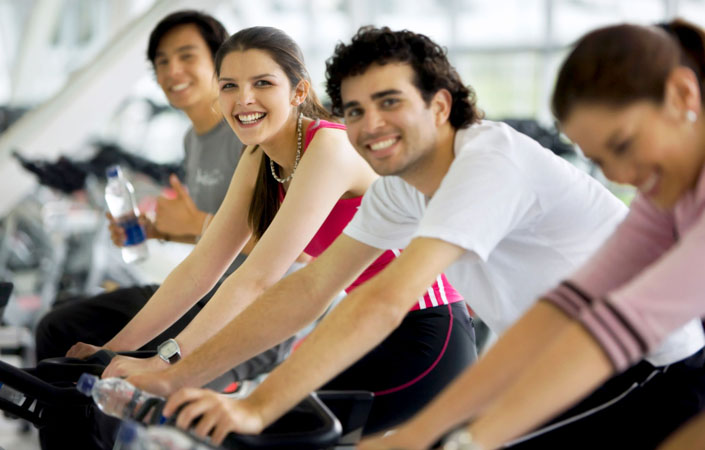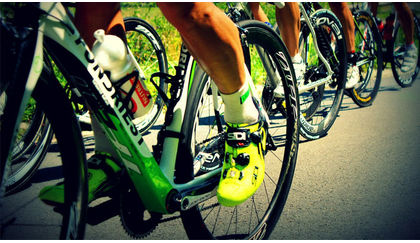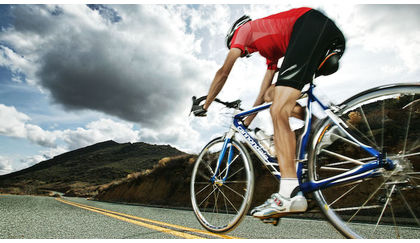
There's nothing wrong with a stationary spin class in a gym - the enclosed space, recirculated air, fluorescent lights, prescribed routine, a funny bike that doesn't go anywhere covered in a towel to soak up pools of sweat and saliva... what's not to like? Gyms are fine, I suppose, if it's snowing or if it also doubles-up as a bomb shelter and this is the dawn of the apocalypse...
Sorry, I shouldn't be too hard on spin classes - they can result in great fitness benefits. The problem I have is they are so BORING! The joy of cycling is wind in the hair, adventuring miles from home, finding a big hill to climb, riding in a bunch and talkin' it up, the thrill of a close shave with a crazy car hoon - well, maybe not the last one, but you get the picture.
Here are a few reasons why a spin class can't replace getting out on the road on a real bike.
1. Riding in the environment

The spin class is a prescribed environment with everything in order, quiet and comfortable. This is completely different to riding outside. The first thing you will notice is the wind... and then the rough tarmac... and then the hills! In a spin class the rider determines the difficulty - on a real bike the difficulty is determined by the environment.
Even with a high resistance setting, a stationary bike cannot replicate the effort required to ride successfully with all these natural impediments taking place simultaneously. The added effect, as mentioned under 'Endurance', is that it impacts the whole body.
2. Learning skills
You can ride a trainer with your eyes closed, while an outdoor bike ride is a whole body workout! There is a plethora of skills you simply don't need indoors like gear shifting, bike handling, cornering, braking, bunch riding skills...
The strongest legs in the bunch are worthless if you don't know which gears to use or how to handle a bike smoothly.
3. Endurance and Conditioning
A spin class rarely goes beyond 45 minutes, which is fine for getting fitter in a class, but doesn't mean an awful lot if you plan on riding for 50 miles or beyond on the road. Cycling is an endurance sport and endurance can only be trained by spending time outdoors, on a bike.
This isn't just about your ability to pedal for long periods; it also means training your whole body. Even with a good bike fit, the standard riding position can result in fatigue and pain in your hands, arms, shoulders, neck, as well as the legs and feet, especially after a decent amount of time in the saddle - and let's not forget the posterior. Endurance is also about toughening up your bum!
There is also hydration and food intake to manage which is crucially important if you start embarking on longer rides. A spin class will increase your fitness, but if your goal is to become fitter, stronger, and more powerful, you need to ditch the trainer and do some real miles.
If your plan is to race or participate in a road cycling event or triathlon then there is simply no substitute to getting on a proper bike and doing the work outdoors!
This may all sound daunting but the satisfaction is like being born again! Here is how to get there:

1. Equipment
The first hurdle to cross is getting the right equipment. Let's assume you have been to your local bike shop and are kitted out with a bike, shoes, helmet, clothing, and the essentials like a mini pump and spare tube. The most important thing at this stage is to make sure the bike is correctly fitted to you - this will ensure you are comfortable for the many hours of cycling ahead.
2. Practice basic skills
One of the first skills is to feel confident clipping in and out of your pedals. It isn't as difficult or dangerous as you may think, although a little more challenging than doing it sitting on a stationary bike.
RELATED:: The art of clipping in
Next up is getting comfortable and confident on the bike itself. Once you are happy with your clipless pedals, this will require merely a handful of rides - most people pick it up pretty quickly.

The part that takes time is learning your gears. Two chainrings and ten or eleven cogs makes for a good spread of choices. Try to keep the cadence high enough (an easier gear) so you aren't pushing hard and feeling the burn in your legs. There are times for the 'burn' in training, of course, but it is unnecessary when just learning the ropes. Find your comfortable zones first and recognize that this will change because of the dynamic environment that the gym can't replicate.

TIP: Becoming bike aware. Bike awareness is a skill that encompasses everything to do with being conscious of your immediate environment. You will quickly find that being alert for pot holes, road furniture, pedestrians, vehicles, or the riders around you in a bunch, becomes second nature. Take time before every outing to acknowledge your intention to remain aware for the duration of the ride, keep your eyes up, and stay safe.
RELATED:: Road cycling checklist for beginners
3. Find a beginners group
The quickest way to get moving on a road bike? Find a bunch that caters to new riders and learn from the experienced. Riding in a bunch teaches so much - bike handling, smooth riding, regulating speed and effort, delicate brake control - it just can't be replicated anywhere else.
Cycling groups are generally friendly and welcoming and most are more than willing to help someone convert from a spin class to the open road.

RELATED ARTICLE:
5 minute drills to make you fast: Pedaling technique
Pedaling seems pretty simple, but when you break it down into its component phases it becomes evident that a good pedal stroke can save you energy and a poor one can waste power and effort... READ MORE

RELATED ARTICLE:
Bodyweight Exercises - Unleash Your Inner Beast In 5 Minutes a Day!
Next time your riding plans are thwarted, try not to stress; just accept the fact that you’ve missed out on your ride this time, get on with your day, and try to set aside five minutes to do this kick-ass bodyweight workout instead... READ MORE


